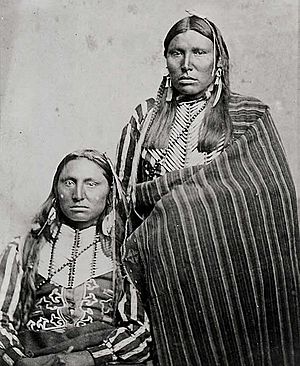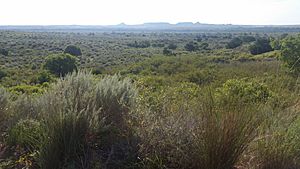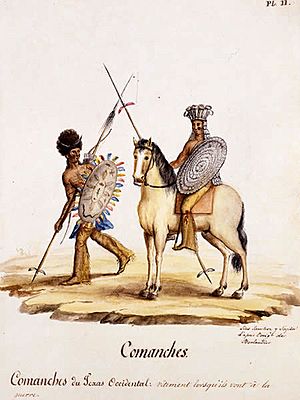Battle of Little Robe Creek facts for kids
Quick facts for kids Battle of Little Robe Creek |
|||||||
|---|---|---|---|---|---|---|---|
| Part of the Comanche Wars, Texas–Indian wars, Apache Wars | |||||||
 Comanche warriors, circa 1870. |
|||||||
|
|||||||
| Belligerents | |||||||
Tonkawa Caddo Anadarko Waco Shawnee Delaware Tahaucano |
Comanche Kiowa Apache |
||||||
| Commanders and leaders | |||||||
Shapley P. Ross Placido-Tonkawa O'quinn-Tonkawa Jim Pockmark-Caddo-Anadarko Jose Casa Maria-Caddo Shot Arm-Waco Jim Linney-Shawnee-Delaware Nid-e-wats-Tahuacano |
Iron Jacket † Peta Nocona |
||||||
| Strength | |||||||
| 100 Americans 113 Indian allies |
200–600 | ||||||
| Casualties and losses | |||||||
| 2 killed and 4–5 wounded | 76 killed 60 captured 400 horses captured |
||||||
The Battle of Little Robe Creek, also known as the Battle of Antelope Hills, happened on May 12, 1858. It was a series of three fights in one day. Texas Rangers, state militia, and their Tonkawa allies attacked Comanche groups. This attack happened in what is now Oklahoma.
At the time, U.S. law did not allow state forces to enter these Indian Territories. This battle was a big step up in the Indian Wars. It was also the first time Texas forces went deep into Comancheria. This area was the homeland of the Comanche people. The battle was a major defeat for the Comanche.
Historians often talk about the Antelope Hills expedition. This was a larger campaign by the Texas Rangers. It lasted from January to May 1858. The Battle of Little Robe Creek was one specific part of this campaign. It included all three fights that happened on that single day.
Contents
Why Did the Battle Happen?
Settlers Move into Comanche Lands
From 1856 to 1858, there was a lot of fighting in Texas. Settlers were moving into the Comanche homeland, called the Comancheria. This meant less land for hunting and for Comanche horses. The Comanche fought back with fierce raids on Texas settlements.
Federal Laws and State Control
The United States Army struggled to stop the violence. Federal troops were often moved away from the area. Also, U.S. laws and treaties stopped state forces from entering Indian Territories. The U.S. Army was told not to attack Native Americans there. This was because some tribes, like the Cherokee, were peaceful farmers. But others, like the Comanche, used the Comancheria for their raids.
Texas had a special situation after it joined the U.S. in 1846. The federal government handled Native American affairs. But Texas kept control of its public lands. This meant the U.S. government could not create reservations in Texas. Texas officials did not want to give up land for reservations. This made peace on the frontier very difficult.
Texas Rangers Take Action
As the Civil War got closer, more federal troops left Texas. This left the frontier open to attacks. Texas Governor Hardin Richard Runnels wanted to stop the raids. He brought back the Texas Ranger battalions.
On January 27, 1858, Governor Runnels chose John Salmon Ford to lead these forces. Ford was a veteran Ranger and Indian fighter. He was ordered to take the fight to the Comanches. Ford was known for being a tough leader. He believed in doing whatever was needed to protect settlers.
Comanche raids were very harsh on settlers. The Comanche often took captives during their raids. Some young captives were adopted into the tribe. The Comanche had become a powerful group. They had learned to use horses and were fierce fighters. They had successfully fought against the Spanish and Mexicans. This made them confident in their tactics.
How Did the Rangers Prepare?
Recruiting Native American Allies
The Tonkawa Indians were old enemies of the Comanche. They lived on a reservation in Texas. Ford decided to recruit them to help his forces. On March 19, 1858, Ford went to the Brazos Reservation. He met with Tonkawa Chief Placido.
Chief Placido agreed to help fight the Comanches. About 120 warriors volunteered, mostly Tonkawa. Scouts were sent to find Comanche camps north of the Red River. Ford and Placido wanted to attack the Comanche strongholds. Their goal was to "destroy their ability to make war."
The Antelope Hills Expedition Begins
In February 1858, Ford set up Camp Runnells in Texas. Governor Runnels told Ford to "follow any and all trails" of hostile Native Americans. He also said to "allow no interference from any source." This meant Ford should ignore federal laws about entering Indian Territories.
On April 29, Ford's Rangers and their Native American allies crossed the Red River. They entered the Indian Territory in Oklahoma. Ford knew he was breaking federal laws and treaties. But he said his job was to "find and fight Indians."
The Battle Unfolds
First Attack: A Surprise Raid
The first fight happened at sunrise on May 12, 1858. Ford's men attacked the first Comanche camp they found. This camp was on Little Robe Creek in the Comancheria. The Tonkawa allies were given permission to attack the sleeping lodges.
Many Comanche women and children tried to escape. The few men who survived tried to protect them. Ford's Rangers also attacked the fleeing Comanches. They used their pistols effectively. Ford reported that it was hard to tell warriors from women. This first attack was a surprise raid on a sleeping village.
Second Attack: Facing a Stronger Defense
The second fight was harder for Ford's forces. They moved further upriver and attacked a larger camp. This camp had about 70 to 100 lodges. Luckily for the Comanche, a warrior had seen the Texans coming. He quickly warned the larger village.
Because of the warning, the Comanche were ready to defend themselves. They protected their women and children. But many warriors were killed. The legendary Comanche Chief Iron Jacket was killed in this fight. He wore a Spanish coat of mail, which had protected him before. But a Tonkawa sharpshooter hit him with a powerful Sharps rifle.
Iron Jacket was an older man, probably in his 60s. He had bravely challenged the Rangers to individual combat. This tactic had worked against earlier enemies. But the Rangers had stronger weapons. His death greatly upset his warriors. Another Comanche leader was also killed. If more Comanche had not arrived, the remaining warriors might have been defeated.
Third Attack: Peta Nocona Arrives
After Iron Jacket's death, Ford's officers wanted to keep attacking. They thought they could easily defeat the remaining warriors. But Ford saw more Native Americans coming from the hills. He ordered his forces to hold their ground.
Iron Jacket had sent messengers for help. His son, Peta Nocona, arrived with reinforcements. Peta Nocona was the husband of Cynthia Ann Parker. He brought at least 100 Comanche warriors. Ford claimed there were 500, but this was likely an exaggeration.
Peta Nocona knew his warriors' bows and lances could not match the Rangers' revolvers up close. He tried to lure the Texans into the woods. This would give his horsemen an advantage. Ford, however, refused to follow. The Comanche also challenged the Texans and Tonkawa to single combat. Ford stopped his Tonkawa allies from accepting these challenges after they lost several fights.
Ford then ordered the Tonkawa to attack in a large group. He hoped this would make Peta Nocona commit all his forces. Then Ford would send in his Rangers with their superior firepower. But the Tonkawa had removed their identifying white headbands. Ford could not tell them apart from the enemy. He signaled them to retreat. Then, Ford ordered a full charge by his Rangers.
Peta Nocona and his warriors retreated from the deadly revolver fire. They knew these new repeating weapons were different. In the past, Comanche warriors could fire many arrows quickly. Their enemies with single-shot weapons would be killed before reloading. Peta Nocona did not want his men caught in the open.
The battle turned into a running fight over several miles. This made the Texans' massed firepower less effective. Most of Peta Nocona's force managed to escape. They bought time for Iron Jacket's people and their own families to flee. They even packed up their lodges and supplies.
More warriors from other tribes, like the Kiowa, were arriving. Ford was outnumbered and low on ammunition. He decided to end the battle. At twilight, Ford began an orderly retreat back to Texas. Before leaving, he burned Iron Jacket's lodges. He also destroyed their food and possessions. Ford reached Camp Runnells on May 21.
What Happened After the Battle?
The Tonkawa warriors celebrated their victory. The coat of mail worn by Iron Jacket was cut up and taken as trophies. Ford returned to Texas, claiming a big victory. He reported killing 76 Native Americans and capturing 16. Official records show 60 casualties.
Ford wanted to raise more Rangers and continue the campaign. But the governor had spent too much money. The Rangers were disbanded after six months.
This battle had a huge impact. It was the first time Texan forces went deep into Comancheria. They attacked villages and returned safely. The U.S. Army later used similar tactics. They attacked villages and destroyed food supplies in their campaigns. This battle also showed a state openly defying the federal government. Texas raised its own military and entered federal territory.
Why Were the Texans Successful?
New Tactics and Weapons
Historians like Frank Secoy and John C. Ewers explain why the Texans won. The Comanche were masters of horsemanship. They used bows, lances, and single-shot firearms. But two things changed the fight. First, the Rangers used new tactics. They traveled light and pursued the Native Americans relentlessly. Second, new rapid-fire pistols and rifles were introduced.
These two factors helped the Texans surprise the Comanche. The new rapid-fire weapons changed how battles were fought. They made the Comanche's traditional tactics less effective. The Comanche had been very successful against the Spanish and Mexicans. They could ride around single-shot gunmen and kill them before they reloaded. But repeating firearms changed this.
Destroying Resources
The Rangers also used "scorched earth" tactics. This means they destroyed everything. They burned Comanche lodges and destroyed food supplies. They also captured horse herds. This left the survivors with nothing.
Attacking non-fighters, like women and children, had happened before. But this battle marked a turning point. It showed these attacks being used openly as a war tactic. The Texans had limited success against the Comanche until repeating firearms arrived. New Ranger tactics also took the fight into the Comanche heartland. The Comanche were defeated and forced to retreat. Peta Nocona's leadership helped his band escape.
Images for kids
-
Capt. John "Rip" Ford was made captain and commander of the Texas Ranger, Militia, and Allied Indian Forces





